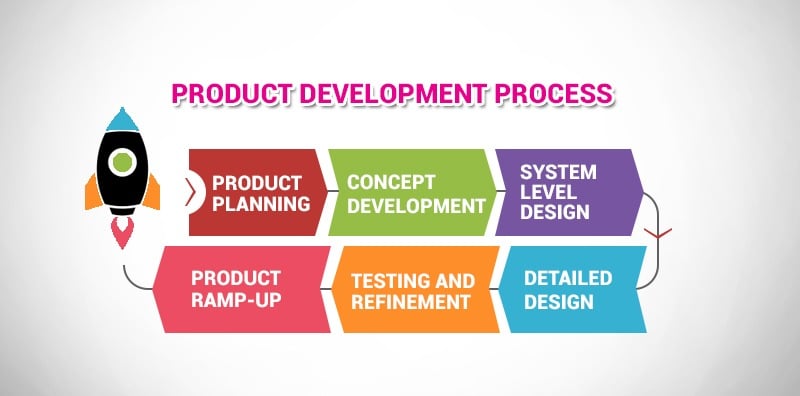優れた製品コンセプトの構築
今、私たちは、ある製品が、そのような製品であることを知る分岐点に立っている。 人が望ましい (さらに詳しく ここ)、その必要性は本物だ。だから、私たちは今、次のプロジェクトに着手する準備ができている。 製品作成プロセス.
しかし、その前に、顧客ニーズを製品のMISSIONステートメントに変換することが重要である。 プロダクトデザイン.
- 商品説明
- バリュー・プロポジション(ベネフィット)
- 主要事業目標
- プライマリー・マーケット
- セカンダリーマーケット
- ステークホルダー
このミッション・ステートメントが定義されたら、顧客ニーズをもう少し詳しく定義することが重要です。ここでは、スーパーマーケットで使用されるショッピングカートを例に、商品の一次ニーズ、二次ニーズ、潜在ニーズを定義する方法を見てみましょう。
- 主なニーズ - 頑丈で、重いものを運べるものでなければならない。移動可能でキャスター付きである必要がある。
- 二次的ニーズ - 軽くて扱いやすく、見た目もすっきりしている。
- 潜在的(隠れた)ニーズ - "子供にも安全で、壊れやすい商品を保護でき、カートの中の商品を追跡できるなら、これ以上のものはないでしょう!"
それでは、解決策を模索し、その解決策を実行に移し、さらに洗練させていく、製品の「創造」段階に入る方法を見ていこう。
で デザイン思考私たちは、このプロセス全体を3つの段階に分けています:
- エクスプロア - この段階では、類似商品を見たり、市場やその商品を研究したりと、広範囲に及ぶ現地調査に出かける。
- クリエート - ブレインストーミングを通じて製品コンセプトを開発し、デザインし、プロトタイプを作成します。
- インプリメント - 製品コンセプトを構築し、コンセプトテストを繰り返し、改良する。
典型的な製品開発プロセスは以下のようになる。
では、コンセプト開発のプロセスをもう少し掘り下げてみよう。ここでは、顧客のニーズを 具体的な測定可能目標 これは製品のターゲット仕様と呼ぶことができる。そして、ブレーンストーミング、アイディエーション、イノベーションを通じて製品コンセプトを生み出すことができる。そしてこの時こそ、アイデアを出し惜しみすることなく、すべてをテーブルの上に並べる絶好のチャンスなのです。ここから、構造化されたダウン・セレクションのプロセスを経て、私たちは実装のために望ましい製品コンセプトを選択することができる。選ばれたコンセプトを検証し、それが顧客のニーズに合致していることを確認する。そして最後に、実装に入る前に、最終的な仕様を設定し、以下のものを考え出すために、下流の開発計画を行います。 開発計画.
以上のプロセスを通じて、私たちは3つの点を常に念頭に置く必要がある:
- デザインの経済効果
- 競合製品のベンチマーク
- プロトタイプの製作とテスト
製品コンセプトの開発は反復プロセスであり、最初に深く掘り下げれば掘り下げるほど、成功する製品を生み出し、実装段階での手戻りを減らすことができる。素晴らしいアイデアを持つには......たくさんのアイデアを持つこと」と言われるように、より多くのアイデアを持ち込めば持ち込むほど、素晴らしい製品をデザインできる可能性が高まります!
次回は、製品コンセプトから実装面を掘り下げていく!
ご期待ください!














